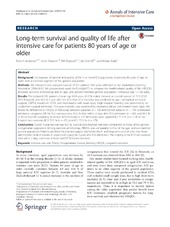| dc.description.abstract | Background: Comparison of survival and quality of life in a mixed ICU population of patients 80 years of age or older with a matched segment of the general population. Methods: We retrospectively analyzed survival of ICU patients ≥80 years admitted to the Haukeland University Hospital in 2000–2012. We prospectively used the EuroQol-5D to compare the health-related quality of life (HRQOL) between survivors at follow-up and an age- and gender-matched general population. Follow-up was 1–13.8 years. Results: The included 395 patients (mean age 83.8 years, 61.0 % males) showed an overall survival of 75.9 (ICU), 59.5 (hospital), and 42.0 % 1 year after the ICU. High ICU mortality was predicted by age, mechanical ventilator support, SAPS II, maximum SOFA, and multitrauma with head injury. High hospital mortality was predicted by an unplanned surgical admission. One-year mortality was predicted by respiratory failure and isolated head injury. We found no differences in HRQOL at follow-up between survivors (n = 58) and control subjects (n = 179) or between admission categories. Of the ICU non-survivors, 63.2 % died within 2 days after ICU admission (n = 60), and 68.3 % of these had life-sustaining treatment (LST) limitations. LST limitations were applied for 71.3 % (n = 114) of the hospital non-survivors (ICU 70.5 % (n = 67); post-ICU 72.3 % (n = 47)). Conclusions: Overall 1-year survival was 42.0 %. Survival rates beyond that were comparable to those of the general octogenarian population. Among survivors at follow-up, HRQOL was comparable to that of the age- and sex-matched general population. Patients admitted for planned surgery had better short- and long-term survival rates than those admitted for medical reasons or unplanned surgery for 3 years after ICU admittance. The majority of the ICU non-survivors died within 2 days, and most of these had LST limitation decisions. | en_US |

